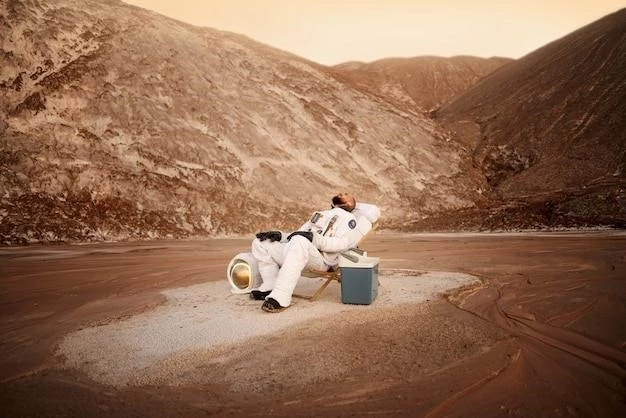Space exploration has always captivated humanity, fueling our curiosity about the vast and mysterious universe we inhabit․ Over the decades, numerous missions and observations have yielded groundbreaking discoveries that have reshaped our understanding of the cosmos and our place within it․ Here are ten of the most significant space discoveries that have expanded our knowledge and inspired future generations of explorers:
1․ The Detection of Gravitational Waves
In 2015, the Laser Interferometer Gravitational-Wave Observatory (LIGO) made an unprecedented detection that sent ripples through the scientific community – gravitational waves․ These waves, predicted by Albert Einstein’s theory of general relativity, are disturbances in the fabric of spacetime caused by the acceleration of massive objects, such as black holes or neutron stars․ LIGO’s discovery provided the first direct evidence of these elusive waves and opened up a new window into the universe, allowing us to study some of the most violent and energetic events in cosmic history․
2․ Evidence of Water on Mars
The search for extraterrestrial life has long focused on Mars, our neighboring planet․ In recent years, numerous missions have provided compelling evidence that liquid water, a key ingredient for life as we know it, once flowed on the Martian surface and may still exist in underground reservoirs․ From the discovery of ancient riverbeds and lakebeds to the detection of hydrated minerals, these findings suggest that Mars may have once been habitable and could potentially harbor microbial life today․

3․ The Confirmation of Exoplanets
Prior to the 1990s, the only planets known to exist were those within our own solar system․ However, with advancements in telescope technology, astronomers began to detect planets orbiting other stars, known as exoplanets․ The first confirmed exoplanet, 51 Pegasi b, was discovered in 1995, and since then, thousands more have been identified․ These discoveries have revolutionized our understanding of planetary systems and increased the likelihood of finding other worlds that could support life․
4․ The Hubble Deep Field Image
In 1995, the Hubble Space Telescope captured an image that would forever change our perspective on the vastness of the universe – the Hubble Deep Field․ This seemingly empty patch of sky, about one-24-millionth of the whole sky, revealed thousands of galaxies, each containing billions of stars․ This groundbreaking image demonstrated the sheer scale and diversity of the universe and highlighted the incredible power of space telescopes to peer deep into the cosmos․

5․ The Cassini-Huygens Mission to Saturn
Launched in 1997, the Cassini-Huygens mission provided unprecedented insights into Saturn, its rings, and its moons․ Over its 13 years in orbit, Cassini captured breathtaking images of Saturn’s swirling atmosphere, its intricate ring system, and its diverse collection of moons․ The Huygens probe, which landed on Saturn’s largest moon, Titan, revealed a world with a dense atmosphere, methane lakes, and the potential for prebiotic chemistry․
6․ The Discovery of the Cosmic Microwave Background Radiation
In 1964, astronomers Arno Penzias and Robert Wilson stumbled upon a faint hum of microwave radiation coming from all directions in the sky․ This radiation, known as the cosmic microwave background (CMB), is the afterglow of the Big Bang, the event that is believed to have created the universe․ The discovery of the CMB provided strong evidence for the Big Bang theory and has been instrumental in studying the early universe․
7․ The Voyager Missions to the Outer Solar System
Launched in 1977, the Voyager 1 and Voyager 2 spacecraft embarked on a grand tour of the outer solar system, visiting Jupiter, Saturn, Uranus, and Neptune․ Along the way, they captured stunning images and collected valuable data that revolutionized our understanding of these giant planets and their moons․ Voyager 1, now the farthest human-made object from Earth, continues to explore the interstellar medium, the region between the stars․
8․ The Landing of the Curiosity Rover on Mars
In 2012, the Curiosity rover touched down on the surface of Mars, beginning its mission to explore the planet’s geology and search for signs of past or present life․ Curiosity, the largest and most capable rover ever sent to Mars, has made groundbreaking discoveries, including evidence of ancient lakes and streams, organic molecules, and seasonal variations in methane levels․
9․ The New Horizons Flyby of Pluto
In 2015, the New Horizons spacecraft made history by becoming the first spacecraft to fly by Pluto, the dwarf planet located in the distant Kuiper belt․ New Horizons’ close-up images revealed a surprisingly diverse and geologically active world, with towering mountains, vast plains, and a complex atmosphere․
10․ The James Webb Space Telescope
Launched in 2021, the James Webb Space Telescope (JWST) is the largest and most powerful space telescope ever built․ With its advanced instruments and infrared capabilities, JWST promises to revolutionize our understanding of the universe, from the first stars and galaxies to the atmospheres of exoplanets․ JWST has already yielded breathtaking images and groundbreaking discoveries, pushing the boundaries of our knowledge and inspiring future generations of astronomers․
These ten space discoveries represent just a glimpse into the vast and ever-expanding realm of our universe․ As technology continues to advance and our understanding of the cosmos deepens, we can expect even more groundbreaking discoveries in the years and decades to come․










